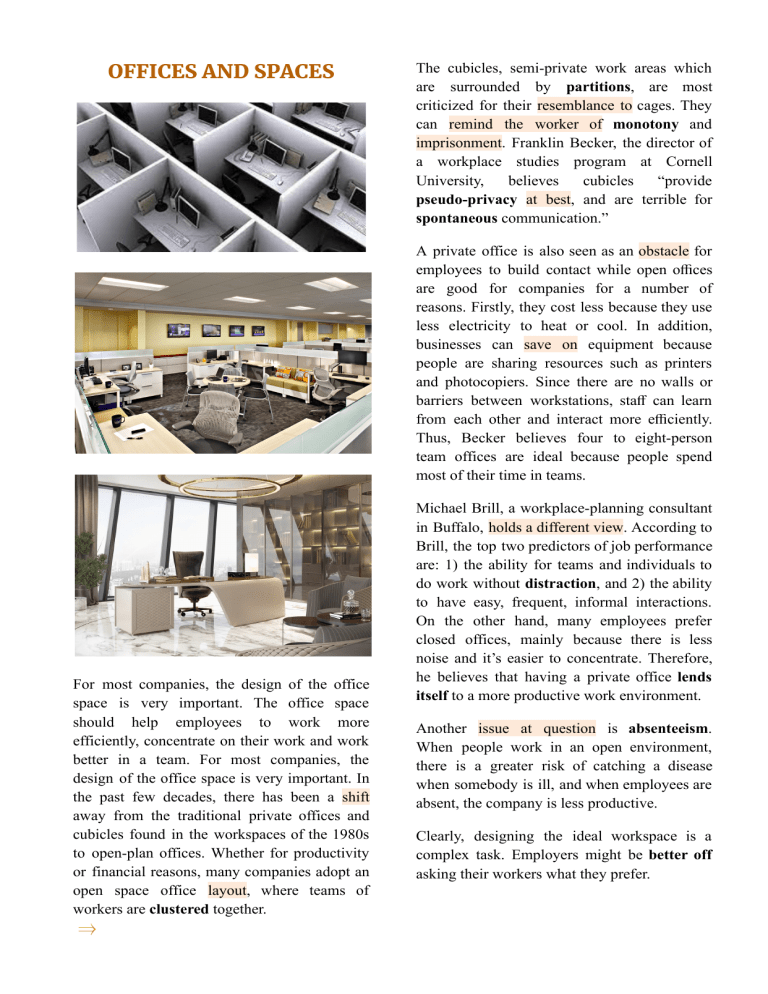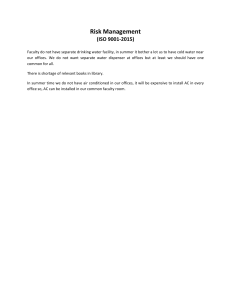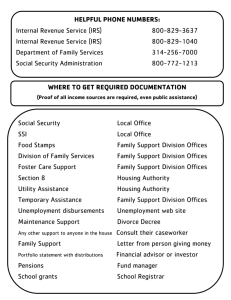
OFFICES AND SPACES The cubicles, semi-private work areas which are surrounded by partitions, are most criticized for their resemblance to cages. They can remind the worker of monotony and imprisonment. Franklin Becker, the director of a workplace studies program at Cornell University, believes cubicles “provide pseudo-privacy at best, and are terrible for spontaneous communication.” A private office is also seen as an obstacle for employees to build contact while open offices are good for companies for a number of reasons. Firstly, they cost less because they use less electricity to heat or cool. In addition, businesses can save on equipment because people are sharing resources such as printers and photocopiers. Since there are no walls or barriers between workstations, staff can learn from each other and interact more efficiently. Thus, Becker believes four to eight-person team offices are ideal because people spend most of their time in teams. For most companies, the design of the office space is very important. The office space should help employees to work more efficiently, concentrate on their work and work better in a team. For most companies, the design of the office space is very important. In the past few decades, there has been a shift away from the traditional private offices and cubicles found in the workspaces of the 1980s to open-plan offices. Whether for productivity or financial reasons, many companies adopt an open space office layout, where teams of workers are clustered together. ⇒ Michael Brill, a workplace-planning consultant in Buffalo, holds a different view. According to Brill, the top two predictors of job performance are: 1) the ability for teams and individuals to do work without distraction, and 2) the ability to have easy, frequent, informal interactions. On the other hand, many employees prefer closed offices, mainly because there is less noise and it’s easier to concentrate. Therefore, he believes that having a private office lends itself to a more productive work environment. Another issue at question is absenteeism. When people work in an open environment, there is a greater risk of catching a disease when somebody is ill, and when employees are absent, the company is less productive. Clearly, designing the ideal workspace is a complex task. Employers might be better off asking their workers what they prefer. 1. In the text, find the English equivalents for the words and phrases below. 1. нагадувати працівникам про; 6. схожість з; 2. зсув; 7. дотримуватись іншої думки; 3. проблемне питання; 8. перешкода; 4. у кращому випадку; 9. ув’язнення; 5. розташування; 2. Match the words with their meaning as used in the text. 1. cluster (verb) 2. partition 3. monotony 4. collaboration 5. pseudo6. spontaneous 7. distraction 8. lend itself to (verb) 9. better off 10. absenteeism A. B. C. D. E. F. G. H. I. J. unplanned, impromptu dullness, repetitiveness division, wall diversion, disturbance false, not genuine cooperation come together in a group be suitable for something absence from school or work better level of comfort 3. Discuss the questions. 1. 2. 3. 4. 5. 6. What kind of office do you prefer? What do you think of open-plan offices? Would you like to work in a different office? Why? What does the author believe is the most obvious criticism of cubicles? According to Franklin Becker, what should companies promote? List the advantages and disadvantages of different types of offices. 4. Find the examples of the passive voice.



